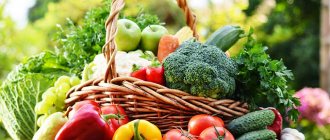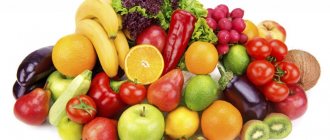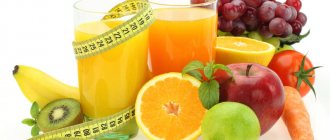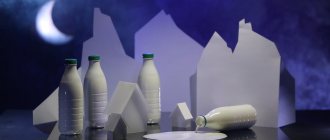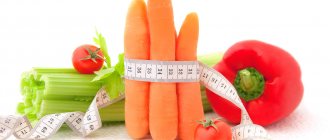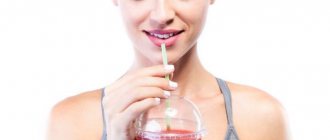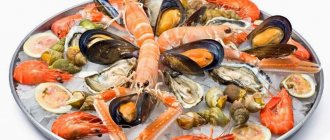Diet for heartburn and belching
May have a physiological or pathological origin.
It is a release of air, sometimes with a small amount of gastric juice that has accumulated in the digestive organ. Air enters the stomach constantly, it helps maintain pressure in the digestive tract. During normal operation of the system, air comes out unnoticed by humans in small portions. Under the influence of temporary or permanent negative factors, the muscles contract and air escapes through the mouth. If a pathological process develops, relaxation of the sphincter muscles is observed, due to which the contents of the stomach enter the esophagus, and belching of sour and bitter air appears. Heartburn and belching occur in healthy and sick people. In the first case it is symptomatic, in the second it is regular.
To get rid of this unpleasant phenomenon, you need to follow a diet. The duration of the therapeutic intervention depends on the cause and complexity of the situation. If belching with heartburn appears against the background of gastritis, you need to adhere to a strict diet for 1-2 weeks, eat right all the time to prevent relapses.
Provocateurs of belching:
- Carbonated drinks;
- Beer;
- Alcohol;
- Juice;
- Oxygen cocktails;
- Onion;
- Ice cream;
- Legumes;
- Cabbage;
- Tomatoes;
- Grape;
- Plums.
To get rid of this unpleasant phenomenon, you need to avoid foods that cause increased gas formation. Follow the rules described in the first section.
Proper preparation
You can’t give up your favorite and healthy dish. To protect yourself, you need to adhere to the correct cooking technology. Increasing the time spent is not a very high price to pay for health. Correct cooking sequence:
- You need to buy coarse grains.
- Pour into dishes in an amount three times less than expected.
- Pour into a boiling container and add three times the amount of water.
- Use seasonings if the stomach does not have pathologies. Otherwise the product is not seasoned.
Cook the cereal for 20 minutes over low heat. Then they check the readiness of the product. If the consistency is thick, you need to let it brew for about 10 minutes. If you avoid burning, the porridge will not spoil and will be tasty and healthy.
Heartburn is not a reason to refuse a healthy product. The correct choice of cereals, processing and cooking recipe do not allow a burning sensation in the chest to bother a person. If the symptom is intrusive, you need to consult a doctor and undergo an examination. If the disease is cured, it is possible to enjoy and benefit from the product.
Buying food shouldn't mean going cheap. Instant cereals do not replace analogues and are considered harmful. If you prefer coarse grains and cook with water, you will save your own time in the future and a healthy body.
Source
Heartburn is a feeling of discomfort associated with a burning sensation behind the breastbone. It is the result of increased acidity of gastric juice, which is thrown into the esophagus, irritates its mucous membrane and leads to heartburn. Often, an increase in acidity in the stomach is caused by poor nutrition, which causes an increase in the secretion of hydrochloric acid by the cells of the gastric mucosa.
Author of the article
Master of Medicine, family doctor, Sumy
Allowed food products
Is it possible to drink milk if you have heartburn?
Is it possible to have milk for heartburn? To prevent complications or resumption of heartburn attacks, study the list of products that do not cause additional acid production, which are acceptable for this symptom:
- Oil (butter, olive, sunflower);
- Lean poultry, fish;
- Legumes you can eat include peas;
- Lean beef;
- Eggs (soft-boiled, omelet);
- Potato;
- Zucchini, eggplant;
- Pumpkin;
- Carrots, bell pepper;
- Pasta;
- Porridge (rice, oatmeal, buckwheat, multigrain);
- Low-fat yogurt;
- Dried fruits compote;
- Hard low-fat cheese;
- Beets (a little, if used correctly);
- Milk, curd masses;
- Bread (white, with cereals);
- Yeast-free dough;
- Dried apricots;
- Tea (green, herbal);
- Bananas, melon, sweet apples, grapes, strawberries.
These products do not burden the stomach, do not provoke acid production, and help with heartburn. For gastritis, the list may differ.
What helps?
Diet for heartburn in the third trimester
If you experience regular discomfort and a burning sensation in your chest, you should be particularly responsible when choosing food. Certain foods and drinks cause additional complications and may make heartburn symptoms worse. And here it is impossible to predict with one hundred percent probability which food will have a negative effect and which will have a positive effect.
However, there are products that are considered gentle and not so aggressive to the microflora of the gastrointestinal tract. Here are some foods that relieve stress on the stomach and help fight heartburn:
- potato;
- lean fish;
- whole wheat bread;
- olive and linseed oil;
- mineral non-carbonated drinks;
- some vegetables, such as carrots and cucumber;
- skim milk and other dairy products;
- non-acidic fruits such as banana, grapes and strawberries.
Our diet also contains foods that have a detrimental effect on the stomach, as they lead to the production of additional acid. These include:
- coffee;
- smoked meats;
- citrus;
- hot spices;
- French fries;
- all types of alcohol, etc.
To track foods that cause acidity, we recommend starting a journal. In it, you can note which foods cause heartburn and how severe the symptoms are. To get a complete picture, fill out the diary every day for at least two weeks. Then discuss the results with your doctor.
Eating the right foods to reduce acid production and maintaining a healthy lifestyle are important in the first steps in the fight against heartburn. 5 tips to reduce heartburn symptoms:
5 tips to reduce heartburn symptoms:
- Eat small snacks.
- Chew your food slowly.
- Use as little fat as possible in your diet.
- Don't eat late.
- The last meal should take place 2-3 hours before bedtime.
The above are basic tips. By following them, you will get relief literally immediately.
In the following chapters we will answer questions about what foods you can eat and what helps with heartburn.
Properties of different cereals
The benefits of porridge cannot be denied. Boiled cereals protect the stomach and have a beneficial effect on the functioning of the gastrointestinal tract. It is not enough to choose any one that comes to hand in the store. Manufacturers, using the desire to save consumers time, have developed mixtures of various additives:
- Dried fruit muesli is familiar to everyone.
- A popular product is oatmeal, which can be cooked in boiling water in a few minutes.
Both options are unacceptable for people with a sick stomach and prone to heartburn. Fine grinding of such products contains an excess amount of starch. The stomach breaks it down into sugar, which causes the accumulation of excess weight. Excess body weight contributes to gastrointestinal disorders. Only healthy people are allowed to consume sugar in honey in moderation.
Let's understand the reasons
Misconceptions about soda: should you take soda for heartburn?
Before moving on to the main topic of the article and understanding what you can eat if you have heartburn, I would like to focus a little attention on the disease itself. So, a person notices an unpleasant burning sensation in the esophagus, which is a consequence of the contact of the stomach contents with the mucous membrane of the esophageal tube. The consequences of heartburn can be completely disappointing: it often marks the development of tumors, inflammation, and erosion. That is why you should not ignore the symptoms, especially if they begin to become regular.
The main causes of heartburn include:
- chronic diseases - gastritis, stomach ulcer;
- defenselessness of the esophageal mucosa against the effects of acids;
- individual intolerance to certain products, causing a similar reaction;
- excessive physical activity.
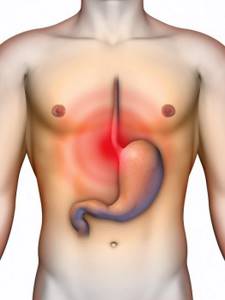
Heartburn can have dire consequences, which is why burning and discomfort in the esophagus certainly should not be ignored. If you follow a diet, you will be able to bring your stomach and intestines back to normal.
You can eat
If you suffer from heartburn, your doctor will tell you what you can eat. Discomfort and burning in the stomach is a rather unpleasant illness. The functioning of the stomach is affected by improperly processed food, as well as foods that irritate the mucous membrane.
It is necessary to understand what kind of diet is needed and create a menu for heartburn under the supervision of specialists, since some foods help with heartburn, while others, on the contrary, provoke it. It's better to create a menu for the week and see what happens. In this way, you can choose a list of dishes that will not provoke attacks of burning and pain.
Gastronomic causes of heartburn
First of all, you need to firmly remember which foods should not appear on your table - foods that cause heartburn:
- sharply sour fruits: lemons, sour berries (lingonberries, cranberries), unripe fruits;
- sour seasonings: various types of aromatic, balsamic and simple food vinegar, both 9% and 6% strength; This is what people especially like to “dip” dumplings in;
- anything that contributes to irritation of the mucous membrane of the esophagus and stomach - first of all, alcoholic drinks, especially alcoholic carbonated tonics;
- substances that promote the return (reflux) of acidic stomach contents back into the esophagus; these include coffee and various confectionery products containing mint essence (dragée, mint caramel), as well as whole and piece chocolate;
- simple sparkling carbonated drinks, including mineral water; the whole point is that carbon dioxide, when combined with water, forms carbonic acid, which increases acidity, despite the fact that it is weak in chemical activity; in addition, the gas puts excess pressure on the walls of the stomach and opens the sphincter, rushing into the esophagus along with gastric juice;
- all hot seasonings: adjika, mustard, horseradish, chili, black pepper and others;
- baked goods: buns, pastries - they themselves do not increase acidity, but increase gas formation in the stomach, which causes heartburn;
- fatty and fried foods, smoked foods, canned food – everything that is called “heavy food”; these products require “more power” of the stomach, secrete more juice and stay in the stomach for a long time, which increases the risk of heartburn; ham, boiled pork, carbonated meat, sausages, sausages are also not recommended;
- sharp and fatty cheeses;
- whole milk – many people think that when it comes to what foods cause heartburn, it’s definitely not milk! The mistake is that it helps for a short time, but after curdling, the milk proteins stimulate the production of juice, and the unpleasant sensations resume;
- you need to give up fast food: hamburgers, chips, fries; the fat in which all this is cooked also has the ability to cause heartburn and, in addition, may have carcinogenic properties.
For those who do not know how deep-fried belyashi are prepared in kiosks, we provide the details. Have you ever wondered why you never saw fresh oil being poured into the tank, even if you came very early in the morning? Because it is used in the following way: after several days of use, the black oil is settled, frozen, then the black part is thrown away, and the light part, containing carcinogens, is poured back. And so on until all the oil is used up. Of course, not everyone does this, but it allows you to get extra profits through dishonest means.
Heartburn during pregnancy: dietary nutrition
This problem during pregnancy complicates a woman's life. It appears due to changes occurring in the body. Pregnant women experience a change in hormonal levels, as a result of which the sphincter connecting the esophagus and stomach relaxes. Acid ends up in the esophagus precisely because of such changes. The uterus gradually enlarges, which also causes some discomfort. The fetus grows, pressure on the walls of the stomach and placenta increases, which is why heartburn appears. After childbirth, this problem disappears. But to forget about it forever, you need to change your lifestyle.
Pregnant women should follow rules that prevent heartburn:
- Divide the daily diet into small portions, eat often (the stomach will not stretch, and the appearance of stomach acid in the esophagus will be avoided);
- When composing your diet, take into account the trimester of pregnancy; in the first, 4 meals should be taken daily, in the second - 4 - 5 meals, in the third - 5 - 6 meals;
- chew slowly, do not rush; enzymes that facilitate the processing and absorption of food are secreted along with saliva, that is, the digestion process begins in the mouth; the smaller the food, the better and faster it is absorbed, the lower the risk of heartburn;
- eat dinner earlier than before pregnancy, 3 hours before you go to bed, no later;
- After eating, you can’t lie down, so it’s better to sit for a while on the sofa or in a chair, it’s important to sit up straight; While you sit, the food will be digested and gastric juice will not cause heartburn;
- when you eat, drink as little liquid as possible, or better yet, give up drinks altogether; they mix with gastric juice, which leads to its dilution and poor digestion of food;
- drink before meals (25 minutes before) or after eating them (in an hour); if you have a problem such as heartburn, mineral still water, pure water (filtered), ginger and chamomile tea, as well as fennel tea are useful, but do not forget that during pregnancy you can drink this tea in small quantities;
- give up drinks containing gas and sugar;
- do not eat food prepared by frying; eat stewed, boiled, steamed and oven-baked food;
- avoid dishes with high fat content and spicy seasonings;
- during pregnancy, do not eat lard, cream, mayonnaise, sour cream; you can afford just a little butter;
- When buying fish and meat, choose options with minimal fat content;
- during pregnancy, avoid first courses prepared with fatty broths (mushroom, fish and meat);
- limit your consumption of fermented milk products, because A large number of them can cause heartburn; give up yoghurts, choose non-acidic cottage cheese, use fermented baked milk and kefir in small quantities;
- exclude acidic foods from your diet, such as fruits and berries, vegetables (for example, tomatoes, sauerkraut, apples);
- eat stewed vegetables, cheese, boiled meat, pureed vegetable soups, porridge (buckwheat, semolina, oatmeal);
- If you develop symptoms of heartburn, to relieve the attack, use almonds, hazelnuts, grated carrots or raw oat flakes, pumpkin seeds, raw sunflower seeds; To make your heartburn go away, simply chew one of these foods; you can drink 1 tbsp. l. unfried sunflower oil, the discomfort should disappear.

Treatment recommendations
In most cases, to establish a diagnosis, it is enough for the doctor to conduct a thorough interview and examination of the patient. Sometimes additional diagnostic methods are required:
- gastroscopy with determination of gastric juice pH;
- X-ray;
- consultations with ENT doctors;
- assessment of external respiratory function.
In addition to medications and normalization of lifestyle during the acute period, all patients are recommended to change their diet. To treat diseases of the digestive system, table No. 1 according to Pevzner or its modifications is often used. Treatment results are assessed only on the basis of a patient interview and FEGDS data.
Menu for the week
If you have experienced heartburn more than once, a weekly diet that involves excluding only the main dangerous foods will be enough to completely restore the esophageal mucosa and normalize the functioning of the sphincter. In the presence of diseases of the digestive tract, especially those associated with gastroesophageal reflux disease, the diet should be drawn up by a gastroenterologist and adhered to for up to six months. An approximate diet for heartburn and high stomach acidity for a week is as follows:
| Breakfast | Lunch | Dinner | Afternoon snack | Dinner | |
| Monday | Oatmeal porridge on water with a spoon of honey and figs | Milk jelly, homemade bread crackers | Soup with carrots, potatoes and parsley (without onions) | Low-fat cottage cheese casserole with egg whites and a spoonful of sour cream | Boiled veal with baked beets and herbs |
| Tuesday | Steamed cottage cheese soufflé with peaches, unsweetened weak tea | A couple of sweet fruits, low-fat drinking yogurt | Steamed pollock meatballs with cucumber and herb salad in olive oil | Baked beets with apple | Steamed zucchini cutlets with chickpeas |
| Wednesday | Pumpkin and apple casserole, a handful of nuts or dates | Low-fat cottage cheese pancakes with steamed raisins | Boiled chicken fillet with buckwheat porridge on water | Dried fruit compote, biscuits | Fishballs with sweet corn and fresh cucumber |
| Thursday | Rice porridge with dried apricots and a handful of almonds | Rosehip decoction, mild cheese and toasted white bread | Creamy potato and broccoli soup, steamed turkey cutlet | A pair of baked pears with low-fat cottage cheese and honey | A glass of natural yogurt with a banana (preferably overripe) |
| Friday | Corn porridge with raisins and honey | Omelette of 2 eggs (without yolk) steamed with carrots | Vegetable broth with noodles, some steamed beef | Homemade fruit jelly (preferably on agar) | Lazy dumplings with herbs, steamed or boiled |
| Saturday | Oatmeal with water and banana | Oatmeal jelly, biscuits or steamed cheesecakes | Brown rice with asparagus and steamed green peas | Dried wheat bun with a piece of mild cheese, unsweetened green tea | Vegetable broth with chicken meatballs, herbs and egg white |
| Sunday | Bulgur with dried fruits, weak green tea with honey | Grated carrots with a spoon of sour cream and prunes | Low-fat steamed fish with cauliflower | Berry jelly, biscuits | Boiled eggs (1-2 pcs.), dried bread, a couple of sweet peppers |
Delicious recipes
Diet food can be both healthy and tasty. The following recipes are an example of this.
Cottage cheese with dried fruits
Grind the fresh product with a fork or beat in a blender. Wash dried fruits - dried apricots, raisins, prunes, cut into small pieces. Add dried fruits, a spoon, sugar to the curd mass, mix. You can drink it with green herbal tea.
Soup
Throw the chicken meat into the water, after boiling, drain the broth, add water again. After boiling, add a small amount of salt, potato cubes, peeled but not chopped onion, rice. 5 minutes before readiness, remove the onion, add grated carrots, parsley, and butter. Soup with noodles and buckwheat is prepared in the same way.
Chicken cutlets
To prepare minced meat, add salt, chopped onion, egg, and raw potatoes into a meat grinder. Roll into balls and place on a baking sheet in the oven or steamer. Prepare in 20 minutes. It is allowed to roll in ground breadcrumbs and flour.
Milk porridge, vermicelli
To 1 liter of milk add 100 ml of boiled water, 0.5 teaspoons of salt, 2 tbsp. Spoons of sugar. After boiling, throw in the vermicelli and semolina, cook for 5 minutes, season with a small piece of butter. If you are preparing milk porridge from rice or buckwheat, you must first boil it in water until half cooked, then add milk. Milk porridge is cooked in a double boiler for 30 minutes. Throw in the ingredients and select the appropriate mode.

Baked mackerel
The head and fins of frozen fish are cut off, cut in half, then each part is cut along the ridge. They take out the intestines. Salt and place on a wire rack. Cook in the oven at 180 degrees Celsius for 20-30 minutes. Sprinkle with lemon juice.
Cottage cheese casserole
Grind 500 g of cottage cheese with 0.5 tsp. Salt, 3 tbsp. Spoons of sugar. Add beaten egg, 2 tbsp. Spoons of semolina, 1 tsp. Spoon of baking powder, raisins. Grease the molds with butter and sprinkle with ground breadcrumbs. Spread the mixture and pour sour cream on top. Bake in the oven at 180 degrees Celsius for about 45 minutes. The dish will be ready if a golden brown crust appears on the surface.
Chicken legs
Rinse, salt and lightly pepper. Place in a sleeve and place in the oven for half an hour at 180 degrees.
Dumplings with potatoes
For the filling prepare mashed potatoes. For the dough - 1.5 cups of kefir, 0.5 tsp. Spoons of salt, 1 tsp. Spoon of baking soda, 1 egg, tablespoon of sugar, flour - approximately 3 cups. Grind the egg with sugar and salt, pour in kefir, add soda and flour gradually. Knead a dough that is not too stiff. Form flat cakes, lay out the filling, and fold the edges. Steam each portion for 5 minutes. Serve with sour cream. During the remission period, fried onions are added to the puree. Dumplings with any filling are prepared in the same way. The same dough is suitable for dumplings. Just don’t steam them, throw them into boiling water.
Pancakes
Pour 100 g of flour into a bowl, 1 tbsp. A spoonful of starch, add 0.5 tsp. A spoonful of salt, 1 tbsp. A spoonful of sugar, 12 eggs, pour in 1 glass of milk, then gradually add another 400 ml. Mix thoroughly so that there are no lumps, add 1 tbsp. A spoon of vegetable oil. Let stand for 15 minutes. Fry on both sides. Makes approximately 12 thin pancakes. Any filling. Place the wrapped pancakes in the oven for 20 minutes to bake.
Pilaf
Fry chicken, onions, and carrots in vegetable oil. Add 1 cup of rice and add 2 cups of water. Salt to taste. Leave to simmer until done. When almost all the water has boiled away, turn off the stove, wrap the pilaf in a towel, and leave for 20 minutes. The rice grains will reach, the pilaf will be crumbly.
Syrniki
Add 0.5 tsp to 300 g of cottage cheese. Spoons of salt, 1 tsp. Spoon of baking soda, 2 tbsp. Spoons of sugar, 1 egg, glass of flour. Stir. Roll the balls in flour and fry on both sides in vegetable oil. Served with sour cream.
Vegetable stew
Pour vegetable oil into a thick-bottomed pan, throw in the onion, and simmer until golden brown. Then carrots. Throw in potato pieces and fill half with water. Place a bay leaf on top. After 10 minutes they dock. Cook on the stove with the lid closed.
What to eat when you have heartburn
The purpose of the dietary table is to reduce the load on the stomach and restore the functioning of the gastrointestinal tract. Diet rules for heartburn:
- You need to eat in small portions, often. Breakfast, second breakfast, lunch, afternoon snack, dinner. Follow a daily routine. Meals should be at the same time every day.
- Late dinners are not advisable. Try to have your last meal 2-3 hours before bedtime.
- Don't overeat! It is difficult for the stomach to digest food if it is very full from food.
- Chew your food thoroughly and eat slowly.
- Sleeping and exercising after eating can negatively affect your well-being. Therefore, after lunch, walk for half an hour; walking in the fresh air will be good for your health.
- Eliminate foods that are harmful to the body. Fatty foods, spicy foods, fast food.
- Don't over-salt your food. Salty food provokes heartburn and irritates the stomach.
- Food should be warm. Hot foods can cause a burning sensation in the esophagus.
- The menu should consist of plant proteins; reduce the consumption of animal proteins to a minimum.
- Products that reduce stomach acids are permitted. You need to create a menu from this list of products. A tomato eaten for lunch can cause a burning sensation.
- Control the amount of sugar you eat (this includes confectionery, sweets, honey, chocolate). For dessert, try sweet fruits and freshly squeezed juices. Citrus fruits cannot be used for making fresh juice.
- Choose acid-reducing foods for elevated levels.
An unpleasant symptom may be a sign of pathologies of the gastrointestinal tract (for example, with gastritis there is a burning symptom). In this case, a full medical examination is indicated to identify the cause of the burning sensation. During pregnancy, a burning sensation is observed due to changes in hormonal levels and taste habits.
Severe heartburn is relieved with soda water. But it should be taken into account that water with the addition of soda (extinguishing agents) provokes flatulence. This will lead to bloating. It is better to consult a doctor, he can prescribe antacid medications that relieve the burning sensation and suppress acid.
Following a diet for heartburn will help cope with the symptom and normalize the functioning of the gastrointestinal tract. Since heartburn is most often a sign of diseases of the digestive system, proper nutrition will be one of the methods of treatment. With it, an integrated approach will reduce the risks of exacerbations and allow you to cure the disease.
The effect of food on the stomach
Diet for heartburn plays a significant role. Treatment with medications will not give a positive result if a person ignores nutritional advice. If you follow a balanced diet that includes all the necessary vitamins and nutrients, you can eliminate heartburn.
The cause of burning is an imbalance of acid, this can happen from poor nutrition. If you have severe heartburn, avoid foods that cause additional juice production in the stomach for digestion.
Allowed products relieve burning sensation and relieve stomach discomfort. When belching, it is recommended to exclude foods that contribute to increased gas formation (flatulence).
Increased acidity in the stomach can be observed with pancreatitis (inflamed pancreas), gastritis, cholecystitis (inflamed gallbladder), ulcerative colitis, hepatitis (inflamed liver), and during pregnancy. Serious stomach diseases appear as a result of improper lifestyle and nutrition.
It is recommended to first find out the source of the disease in case of constant heartburn, then prescribe treatment. Be sure to discuss your diet plan with your doctor. This way you can choose the optimal diet. Foods allowed for heartburn are selected individually.
Strict contraindications
If you have heartburn, you should not consume products that cause an unpleasant burning sensation in the throat or belching. Ignoring these rules leads to the development of gastrointestinal diseases, exacerbations of chronic diseases, and serious consequences. If heartburn occurs symptomatically, it is necessary to exclude the effect of unfavorable factors. This could be coffee, alcohol, carbonated drinks, pizza, fast food, talking while eating, rushing, overeating, nervous excitement, shock, bending the body, lifting weights, lying down immediately after eating. In the case of gastritis and other gastrointestinal diseases, it is necessary to direct efforts to eliminate the inflammatory process and restore the functions of the digestive tract.
Prohibitions concern not only the type and quality of food, but also diet and behavior.
- Bad habits – alcohol, smoking, drugs, snacking at night, coffee on an empty stomach, kvass.
- Fatty food.
- Sweets, spices, fried foods.
- You should not swallow food in large pieces or talk while eating.
- Physical activity immediately after eating; starting exercise is allowed no earlier than 20 minutes later.
- Lying down immediately after eating.
- Hot, too cold dishes.
- Carbonated drinks.
- Fast foods.
- Products containing chemical additives in the form of flavorings, preservatives, taste enhancers, appetite stimulants.
Avoid wearing tight clothing to prevent compression of the stomach.
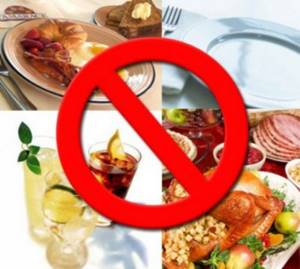
What can you eat for heartburn?
Do heaviness in the stomach, a burning sensation in the chest take away the joy of life? Let's fight heartburn! To do this, we will make a list of products that will relieve heartburn or alleviate symptoms.
What to eat to relieve heartburn?
Let's look at three groups of home remedies:
- fast;
- tasty (for example, honey);
- useful.
Fast
To make heartburn stop quickly, people who have already experienced it advise using soda. A dubious option, but if you need to get rid of a burning sensation behind the sternum quickly, then it will do. But only once.
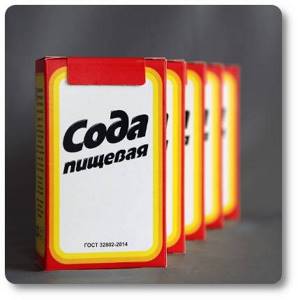
Recipe: a quarter teaspoon of baking soda per glass of warm water. Stir and drink.
Important!
The soda must first be dissolved. You cannot pour soda into your mouth and wash it down. Undissolved crystals will settle on the walls of the esophagus and stomach and cause a burn.
This technique was developed a long time ago and was used by patients suffering from heartburn even before the invention of modern drugs. But you can use the method once or if the burning sensation behind the sternum is extremely rare.
Doctors explain why it is undesirable to use a soda solution on an ongoing basis: soda actually relieves irritation in the esophagus and stomach, as it neutralizes excess acid. But the opposite effect appears: if you neutralize the acid, the stomach “in response” will produce it in even greater quantities. After all, there must be an acidic environment in the stomach - this is necessary for food to be digested.
There is another way to neutralize heartburn - take some buckwheat, fry it in a frying pan until it turns dark brown. Then it needs to be ground to flour. The crushed cereal should be taken half a teaspoon 3 or 4 times a day.
What else can you eat to prevent heartburn? You can take 10 tablets of activated carbon, wash them down with water and first grind them to a powder.
You can drink some water. But this does not mean that you need to quickly swallow a whole glass. It is better to drink warm water, in small sips, always while standing. During the time you drink, the water will wash away gastric juice from the walls of the esophagus and heartburn will stop.
Tasty
Or you can eat something tasty to relieve the heartburn. Pumpkin seeds have proven themselves well. These should be dried seeds, not fried. They have a good enveloping effect.
If you love almonds, then they are also suitable as a remedy for burning behind the sternum.
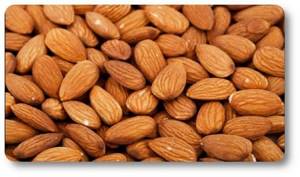
But you don’t need to eat it in huge quantities, a few nuts are enough. In addition, almonds are a high-calorie nut, and you can gain weight if you constantly eat them.
Warm milk drunk with a teaspoon of honey helps many. Milk has a slightly alkaline environment, and therefore it deactivates gastric acid.
Need to know!
This method of treatment is not suitable for everyone: for some, milk causes a backlash and worsens heartburn. This occurs due to individual intolerance to dairy products. Kefir has similar properties: sometimes its use increases unpleasant symptoms. This is verified by individual reaction, that is, experimentally.
You won’t find a medicine tastier than a banana for heartburn! This fruit (only it must be ripe) envelops the walls of the stomach, helping to facilitate its work.

The stomach is protected from excessive exposure to hydrochloric acid, therefore it can quickly get down to its main job - digesting food.
Healthy
Here are some useful heartburn remedies. An affordable, cheap and very simple remedy is carrots. You can gnaw the whole carrot, cook it and drink it fresh, or you can grate it and add a drop of vegetable oil.
Raw potatoes help well, more precisely, potato juice, which you can drink 5 tablespoons.
Exotic Jerusalem artichoke is a vegetable whose properties are somewhat reminiscent of those of potatoes. You need to squeeze the juice from its tubers and take it three times a day a quarter of an hour before meals.
Jerusalem artichoke contains pectin, fiber, proteins - all this improves digestion and helps the stomach cope better with its functions.
If you have severe heartburn, you can eat oatmeal - it contains a lot of plant fiber and very little fat. Oatmeal promotes normal digestion and removal of toxins from the body.
An interesting remedy for burning behind the sternum is raw peas. You should take a few dried peas and chew them. This will shorten the duration of the attack.
How to get rid of heartburn without medications
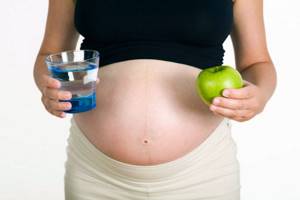
What can you eat if you have heartburn to reduce the likelihood of food refluxing into the esophagus:
- For fruits, fresh and dried apples, bananas, apple juice (not sour) are suitable;
- Vegetables in the diet should include baked potatoes, broccoli, cabbage, carrots, green beans, and peas;
- among meat and protein products, it is better to give preference to lean beef, chicken breasts, lean fish, and egg whites;
- Dishes made from boiled rice, bran, oatmeal, and corn bread will help reduce the manifestations of unpleasant symptoms;
- Still water, some juices and chamomile and calendula teas are suitable as drinks;
- for dessert you can eat low-fat pastries, a little natural marmalade or May honey;
- During an attack, you can make a heartburn fizzy drink from soda and vinegar.
If you have heartburn, you can eat canned and pickled foods, baked goods, tomato sauces, and instant foods with caution. It is better to season dishes with natural, not very hot spices, replacing traditional ready-made seasonings
It is better to season dishes with natural, not very hot spices, replacing traditional ready-made seasonings.
You can eat a little butter a day, drink fermented baked milk and milk (all low in fat).
Dishes should be prepared by boiling, baking and steaming - these processing methods are considered the most gentle.
It is not recommended to fry or cook food over a fire if you have heartburn, especially with the addition of fat, sauces and hot spices.
If you have heartburn, you should not drink drinks, energy drinks, beer, vodka, sour wine, etc.
However, to become completely healthy and get rid of discomfort after eating, medical help is necessary.
Should be considered
Before going on a diet, you should consult your doctor. It is imperative to take into account the characteristics of the body. Not all foods cause a burning sensation in different people. If you are suffering from heartburn, your doctor will tell you what you can eat or what is not recommended and will help you create a diet suitable for everyone.

When treating a disease, a specialist always first recommends following a diet. The doctor must explain exactly why the diet should be followed and how it will affect the patient’s health. It is worth considering that you can completely get rid of the disease only if you follow the recommendations of your doctor.
Basic Rules
The reflux of gastric juice into the esophagus mainly occurs due to incorrect body position during and after meals (within 1-2 hours), against the background of overeating, eating food on the go, or abuse of harmful products - alcohol, pickles, marinades. For this reason, nutrition that helps relieve the current attack of heartburn and prevent a new one is based on the following rules:
- Place a small portion of food on the plate - for meat it is about 60-100 g (depending on whether you plan to add carbohydrates to it or not), for cereals and pasta approximately 50-60 g (implying the weight of the dry product), for vegetables/fruits the allowed volume is 200-300 g. The lower limit of the indicated figures is if you mix everything in one plate in 2 categories (meat with vegetables, vegetables with carbohydrates, meat with carbohydrates), the upper limit is if you eat them separately.
- Don’t starve - the juice produced by the stomach must be used to digest food, so 5-6 meals (and more if you work a long day) per day must happen. Maintain an interval of 2-3 hours between them, especially if you have gastritis or problems with the hepatobiliary system.
- Set your main meal (not a snack) at such a time that you don’t have to immediately run somewhere, go to training or go to bed: you should sit for an hour or a little longer, or walk at a measured pace.
- Avoid eating very hot foods (temperatures above 60 degrees) - they irritate the mucous membranes.
- Avoid cold drinks, desserts - ice cream, some types of cocktails, even just cold water: they not only irritate the esophagus, but also provoke longer production of hydrochloric acid.
- Eat slowly to prevent air from getting in with the food and chew each bite thoroughly.
- Give preference to boiled or steamed foods. If you plan to bake them, do it in foil or a sleeve so as not to create a rough crust. Frying is prohibited.

General rules
Heartburn (a burning sensation behind the sternum and in the throat) is the most common symptom of various gastrointestinal diseases. As a rule, it is a consequence of the reflux of gastric contents into the esophagus (gastroesophageal reflux) and is considered a characteristic symptom of gastroesophageal reflux disease. Heartburn can also be a symptom of esophageal lesions (primary or secondary). Among the primary ones, achalasia of the cardia is distinguished, and from the secondary ones - lesions against the background of scleroderma, myxedema, systemic lupus erythematosus, rheumatoid arthritis, diabetes mellitus, amyloidosis, chronic alcoholism.
The causes of this symptom may be functional conditions or, as mentioned above, diseases:
- Constant overeating - an increase in the volume of the stomach leads to relaxation of the lower esophageal sphincter, which creates favorable conditions for the appearance of pathological reflux.
- Physical activity immediately after eating.
- Changes in mental status (tension, anxiety, depression).
- Gastrointestinal pathology - gastritis, duodenitis, biliary tract diseases, irritable bowel syndrome.
- Increased intra-abdominal pressure, for example due to obesity or pregnancy. An increase in abdominal circumference leads to an increase in intra-abdominal pressure and dysfunction of the esophageal opening of the diaphragm. Constipation is also a cause of high blood pressure.
- Hiatal hernia.
- Failure of the obturator mechanism of the cardia.
- Gastric stasis.
The consequences of reflux of stomach contents and heartburn are the risks of developing the following complications from the esophagus:
- Esophagitis (catarrhal and erosive).
- Ulcers and bleeding.
- Barrett's esophagus (a serious complication manifested by the replacement of the squamous epithelium of the esophagus with a cylindrical one, which is regarded as a precancerous condition. Severe epithelial dysplasia is equivalent to cancer).
- Strictures (narrowing).
- Cancer.
Immediately after waking up, the digestive organs begin physiological activity and prepare the internal organs for food intake: the secretion of digestive juice in the stomach, the production of bile in the liver and the production of saliva by the salivary glands increase.
Hydrochloric acid and bile are active substances and in the absence of food, which reduces their aggressiveness and concentration, they irritate the mucous membrane of the stomach and duodenum. When there is an excess of gastric juice, the sphincter relaxes, which prevents the contents from the stomach from entering the esophagus. During this period, hydrochloric acid can be thrown into the esophagus, causing an unpleasant burning sensation.
In pregnant women, this condition is associated with an enlarged uterus, increased intra-abdominal pressure and compression of the stomach. The situation is aggravated by the action of progesterone, which relaxes the sphincter muscles. Thus, all the prerequisites for the occurrence of heartburn are created. In this regard, skipping food is not acceptable - the morning should begin with a high-calorie breakfast, preferably at the same time, which will reduce the aggressiveness of hydrochloric acid.
It is also known that eating fatty and fried foods in the evening, smoked foods, spicy foods and sauces, drinking alcohol and wine, as well as eating a large meal at dinner cause a several-fold increase in the amount of hydrochloric acid in the gastric juice. This leads to unpleasant sensations immediately after waking up, which can be avoided by proper nutrition during the day and especially in the evening.
Heartburn often occurs from hunger - when dieting and skipping meals. And this is due to the fact that the stomach, which processes portions of food at a certain time, continues to secrete digestive enzymes during the fasting period.
Patients often underestimate the significance of heartburn; they often ignore it or, if it is severe, treat it themselves. However, this is not always justified. Treatment of patients is carried out differentiated.
Patients with episodic heartburn (less than once a week) are prescribed antireflux therapy (for example, alginic acid preparations based on brown algae - Gaviscon and Gaviscon Forte). The advantages of this suspension are visible: it adsorbs pepsin and bile acids, stimulates the secretion of bicarbonate, and the gel protects the mucous membrane of the stomach and esophagus.
Alginates are not absorbed, therefore they do not have a systemic effect, do not accumulate, and act quickly and for a long time. The drug, taken 30 minutes after a meal, creates a barrier that prevents acid from entering the esophagus. Even if reflux occurs, a suspension rather than acidic contents enters the esophagus. Hydrochloric acid remains in the stomach and performs its digestive function. The drug is approved for over-the-counter release.
For patients over 50-55 years of age who experience frequent episodes of heartburn, endoscopic examination is indicated. If erosions in the esophagus are detected, proton pump inhibitors (Omeprazole, Lansoprazole, Rabeprazole, Esomeprazole) are prescribed, which are taken 30 minutes before meals, in combination with alginates. In the absence of erosions, monotherapy with alginates is often used. Of course, the questions of treatment and its duration in all these cases are decided by the doctor. It is important to follow a certain diet during treatment.
Diet and proper nutrition for heartburn are aimed at reducing its frequency and creating conditions to reduce inflammation of the mucous membrane of the stomach and esophagus. In addition to stopping attacks, which improves the patient’s well-being and quality of life, the diet helps prevent complications, in particular reflux esophagitis. It provides:
- Reducing the volume of food - small and frequent (up to 5 times a day) meals; overeating is not allowed, especially at night.
- Following a diet means eating regularly, preferably at the same time.
- Exclusion from the diet of fatty, fried, smoked, sour and sweet foods, which contribute to heartburn.
- It is prohibited to consume alcohol, strong coffee, tea and large amounts of liquid, which increase the reflux of stomach contents.
- Exclusion of spicy and hot dishes.
- For heartburn and belching, it is also recommended to exclude foods that cause flatulence (all drinks with gas, yeast baked goods, fresh bread, legumes, grapes, raisins). These two symptoms are related and excess flatulence can intensify them.
Following simple recommendations will also help avoid heartburn and regurgitation (stomach contents entering the oral cavity):
- The patient should not lie down immediately after eating.
- You need to lose weight if you are overweight.
- Avoid working in a forward position, lifting heavy objects, wearing tight clothes and tight belts - all of these conditions increase intra-abdominal pressure and provoke heartburn.
- Dinner 4 hours before bedtime (it should be light and not too much).
- Use a high pillow while sleeping (raising your head 15-20 cm significantly reduces regurgitation of stomach contents).
- Avoid constipation and flatulence.
- Avoid smoking and drinking alcohol.
- Take alkaline mineral waters as recommended by your doctor.
If there are no concomitant gastrointestinal diseases, then these general principles of nutrition and behavior will help get rid of heartburn and prevent its occurrence in the future. If you have gastritis or esophagitis (especially erosive), nutrition should be taken more seriously, and it will depend on the severity of symptoms and the stage of the disease.
Thus, during the period of exacerbation, the most gentle diet within the limits of Table No. 1A is recommended. Bread and baked goods, broths, all vegetables and fruits in any form, carbonated drinks, coffee, strong tea, cocoa, any sauces and spices are excluded for 7-10 days. The basis of the diet is slimy or pureed soups, liquid pureed porridge with water or milk, thoroughly pureed meat and fish dishes in the form of soufflé and liquid pate. All this is necessary to spare the mucous membrane and speed up its recovery processes.
Proper nutrition for this table includes:
- Meat dishes in the form of a steam soufflé - boiled meat is thoroughly beaten in a blender, beaten egg whites are added and steamed.
- Fish dishes (using lean fish) are also prepared in the form of a soufflé.
- To prepare slimy soups, use baby food flour (oatmeal, rice, buckwheat) or the same cereals, but well boiled. You can add an egg-milk mixture to soups.
- Dishes from pureed cereals are prepared in the form of liquid porridge with water or milk.
- Low-fat milk, calcined cottage cheese and low-fat cream as an additive to dishes.
- Soft-boiled eggs, egg porridge or omelet.
- Kissels and jelly made from berries, excluding fresh berries.
- Weak tea with cream, a decoction of wheat bran.
- With catarrhal esophagitis, there is no need for such a strict diet and the patient can be prescribed Table No. 1B or No. 1 immediately.
Table No. 1B includes:
- Puréed soups already have the addition of pureed vegetables.
- Meat, chicken and fish dishes are already prepared in the form of quenelles, mashed potatoes and cutlets.
- Canned vegetables and fruits (baby food series).
- A limited amount of vegetables (potatoes, carrots, beets and zucchini) can be pureed. There remains a strict ban on raw fruits and vegetables.
- The number of eggs increases (you can eat up to 3 eggs a day - soft-boiled or scrambled eggs).
- Milk up to 4 times a day, fresh cottage cheese is allowed (milk is added to it and pureed), cream is added to dishes, and milk jelly is served as a separate dish for second breakfast or afternoon snack.
- Table No. 1 is complete and at the same time moderately gentle. It contains a reduced amount of animal fats, which reduce sphincter tone and cause heartburn (heavy cream, butter, fatty pork, goose, duck, fatty fish, fatty lamb, pastry creams).
- Irritating foods are also excluded, which include citrus fruits, strong coffee, tea, chocolate, tomatoes, onions, garlic, spices, mint, alcohol - they also reduce sphincter tone.
- The amount of protein increases to 100 g per day, since the protein component of food helps to increase sphincter tone.
- Fractional meals are still recommended, it is also necessary to monitor the calorie content of food - a larger percentage of it should be in the first half of the day, and dinner should consist of easily digestible dishes (porridge, omelettes, cottage cheese, vegetable purees).
- Exclude secretion agents and coarse foods with connective tissue, vegetables with coarse fiber and essential oils (turnips, radishes, onions, garlic, asparagus, legumes), fruits with coarse skin (gooseberries, grapes, dates, currants), bread with bran.
- Food is steamed and, depending on the state of health, can be pureed or finely chopped. It is possible to bake in foil or a sleeve so that a crust does not form.
